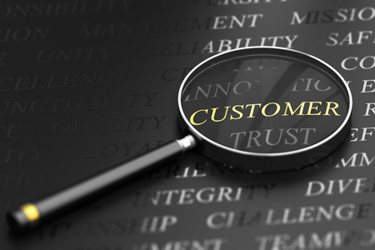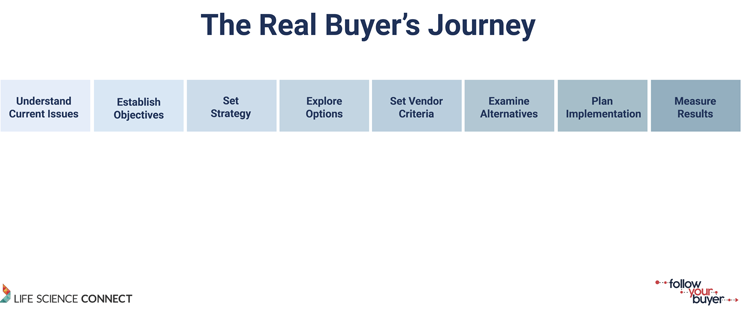Customer-Centered Content Marketing Part 1

By Perry Rearick, Chief Editor, Follow Your Buyer

This is the first of two articles, and more, on customer-centered content marketing. It is intended to help you adopt a customer-centered content marketing strategy that is aligned with the real buyer’s journey. And we’re confident you will achieve remarkable results for your business.
Content marketing is not new and has been around for at least 128 years. One of the most often cited examples of early content marketing is The Furrow, a magazine published by John Deere. It is filled with content to help farmers be better farmers but does not contain a single John Deere ad, nor any ads at all. Yet it helps sustain one of the most loyal customer bases of any brand in the world.
The Furrow editorial team creates content that John Deere’s primary customers, farmers, want. And in doing so, they deliver value that is far greater than anything delivered by a tractor, although their tractors are great too. Creating content that helps farmers employ technology to use water more efficiently or offering an empathetic feature story of life as the last farmer in one’s family, builds trust with a brand that is matched by few.
How is this done? It is easy to grasp intellectually but challenging to execute, because it requires marketers to skeptically question just about everything we’ve learned to do. And there isn’t a one-size-fits-all formula that can be applied to every business. But the sooner you get started, the sooner you’ll create unbreakable trust with a target audience.
The Big Mindset Shift
I must forewarn you! I am about to deliver some intense candor. Most of us are stuck in traditional, outdated approaches to B2B marketing and sales. Our knowledge was built through formal education, likely college, which is comprehensive but lacks depth. It is heavy on theory and light on application. Most programs focus on consumer marketing and avoid B2B.
We learn the four A’s, seven P’s, four stages of the marketing funnel, SWOT, and a sprinkling of Maslow’s hierarchy of needs. We reduce our prospects to data points and develop criteria to determine if they are marketing or sales leads, are they ready to buy, and what hook will we use to reel them in. And we forget that they are real people trying to make complex, costly purchasing decisions.
This calls for a significant shift in our mindset, one that is being driven by the way B2B buyers make purchasing decisions. This requires us first to understand and accept that our target audiences are on a journey to solve problems and their solution may lead to a purchasing decision. Second, if we want to be considered as a solution, we must be a helpful participant in their problem-solving journey.
What is a Content Strategy Centered on How Your Customers Buy?
Buyers navigate an eight-stage journey in their efforts to solve the problems they face or to reach the opportunities they’re missing. See figure 1. They will complete most of this journey before they are ready to reveal themselves to a solution provider. That point occurs somewhere between setting vendor criteria and examining alternatives.

Here is the problem that many of us have. We define the buyer’s journey in three stages: awareness, consideration, and decision. And we define awareness as when a buyer becomes aware of us and our solutions. We then develop content strategies focused on our own products and services, features and benefits, specifications, and how to use them. And most of the content we develop falls into these categories. However, these factors are not important to buyers until the late stages of their journey.
When armed with an understanding of the real buyer’s journey, we quickly come to the realization that our content strategy must address the concerns of buyers in the first five stages of their journey. Rather than focusing our content on our own products and services, we should be addressing the issues our buyers have that will ultimately lead them to us as a solution. Understanding this is simple, putting it into action to attract more business and achieve better results is challenging.
Developing a Content Strategy Aligned with the Buyer’s Journey
In developing a content strategy that is aligned with the real buyer’s journey, let’s start at the end. Spoiler alert, the end is not a sale! Yes, your business certainly wants to drive more sales. But the goal of content marketing is to attract, engage, and retain target audiences. The goal of a customer centered content marketing strategy for the first half of the buyer’s journey is that the vendor criteria set by the buyer in stage five of their journey align perfectly with your solution.
That means we must create marketing content that engages buyers during the first four stages of their journey: understand current issues, establish objectives, set strategy, and explore options.
Potential buyers spend most of their time in the first four stages of the buyer’s journey. And according to Edelman’s annual thought leadership studies, B2B business leaders dedicate time to regularly consume thought leadership content that addresses their needs during these stages.
How to Create an Engaging Content Strategy
The most common question I hear from even the most seasoned content marketers is “what should my content be about?” Here is a process you can use to answer that question for the first four stages of the buyer’s journey. It begins with a series of questions and is effective in brainstorming sessions with members of your team that best know your customers.
Stage 1-Understand Current Issues
What problems do my buyers have that I can help them solve? The answers to this question become the key content topics to help your buyers better understand the issues they face. It’s also helpful to have customer-focused market research data that identifies the most common issues negatively impacting your target audiences.
Are my buyers aware of the problem? This will help you determine how much content you need to build awareness of the issues your buyers have. There’s that awareness word again but defined in a way that is aligned with the buyer’s journey.
How do they describe the problem? The answers to this question become the lexicon you use in your content and featured in your titles, headers, and taglines. You can even use them as part of SEO strategy. Afterall, buyers in this stage are using terms related to their problem, not a defined solution.
How is the problem hurting or hindering your buyer’s business? Capturing the pain in terms of cost, time lost, inefficiencies, loss of competitive advantage, and lack of business growth can serve as the catalyst that helps the buyer move to the next stages of their journey.
Stages 2 & 3-Establish Objectives and Set Strategy
Without jumping to the features and benefits of your own products and services, create content that offers hope that the problems your buyers have can be solved. Keep these topics focused on your buyer, their problems, and the solutions they can pursue. It’s important to keep in mind that your buyer is trying to solve a business problem, so your content should be created in that context.
How-to content is effective at engaging buyers in these two stages. Avoid specific case studies of customers using your products, but rather keep the examples focused on solving the problem the buyer has become aware of.
Focus content on how to establish realistic objectives and develop strategies that work. Offer cost estimates, timing, who to include on the solution project team, and highlight traps to avoid.
Stage 4-Explore Options
Effective plans will include several courses of action that your buyer believes will accomplish their established objectives, but it’s likely that not all of them will be equally effective. At this stage buyers must explore and evaluate options that not only achieve their objectives, but are feasible, acceptable, and suitable for their organization.
This is a great time for content that explores all options available to your buyer, including those of your competitors. However, you should remain focused on your buyer and the information they are seeking.
Content that honestly explores the pros and cons of all options is effective at engaging buyers at this stage of their journey. If your buyer has been engaged with your content since stage one, it is at this stage that a trusting relationship between buyer and solution provider is established.
What about the rest of the buyer’s journey?
We’ll explore the last four stages of the buyer’s journey in our next article. But in summary, the purpose of content marketing is to attract, engage, and retain target audiences. The goal of a customer centered content marketing strategy for the first half of the buyer’s journey is that the vendor criteria set by the buyer in stage five of their journey align perfectly with your solution.
If your content strategy is developed in a way that is aligned with the first four stages of the buyer’s journey, the buyer seeks you out to help them navigate the rest. And isn’t that what you want?
Aligning your content marketing strategy with the real buyer’s journey is a big topic. And we will continue to explore it with you to help you make it your strategy.
